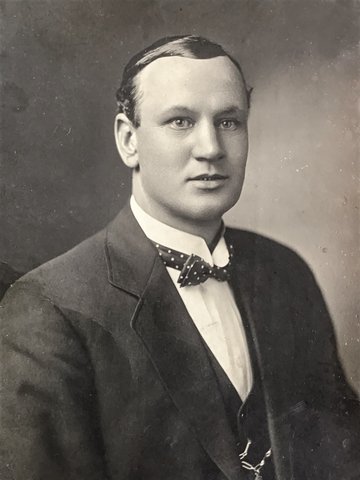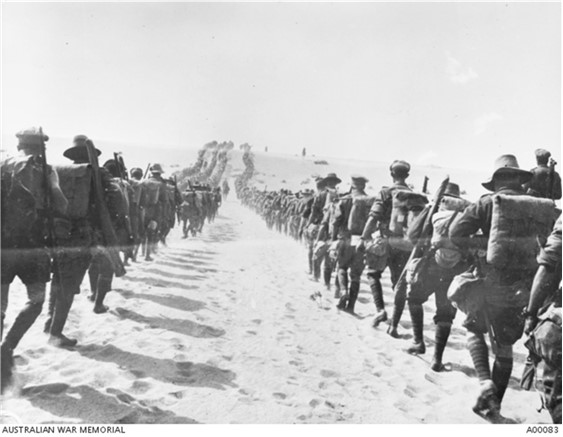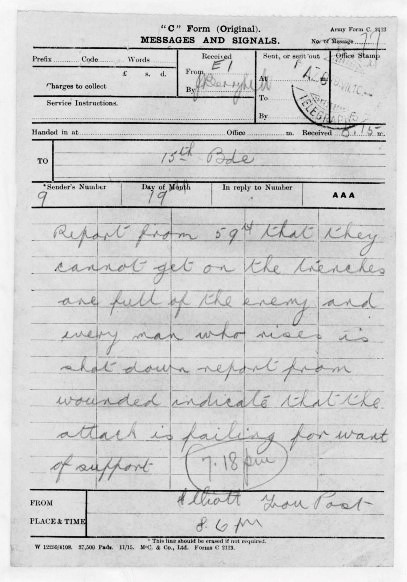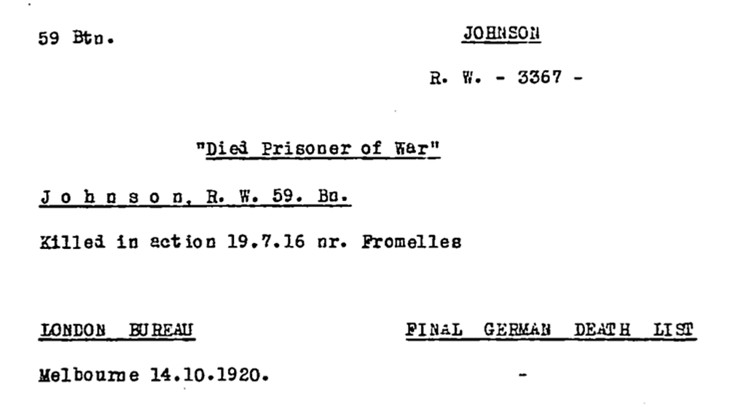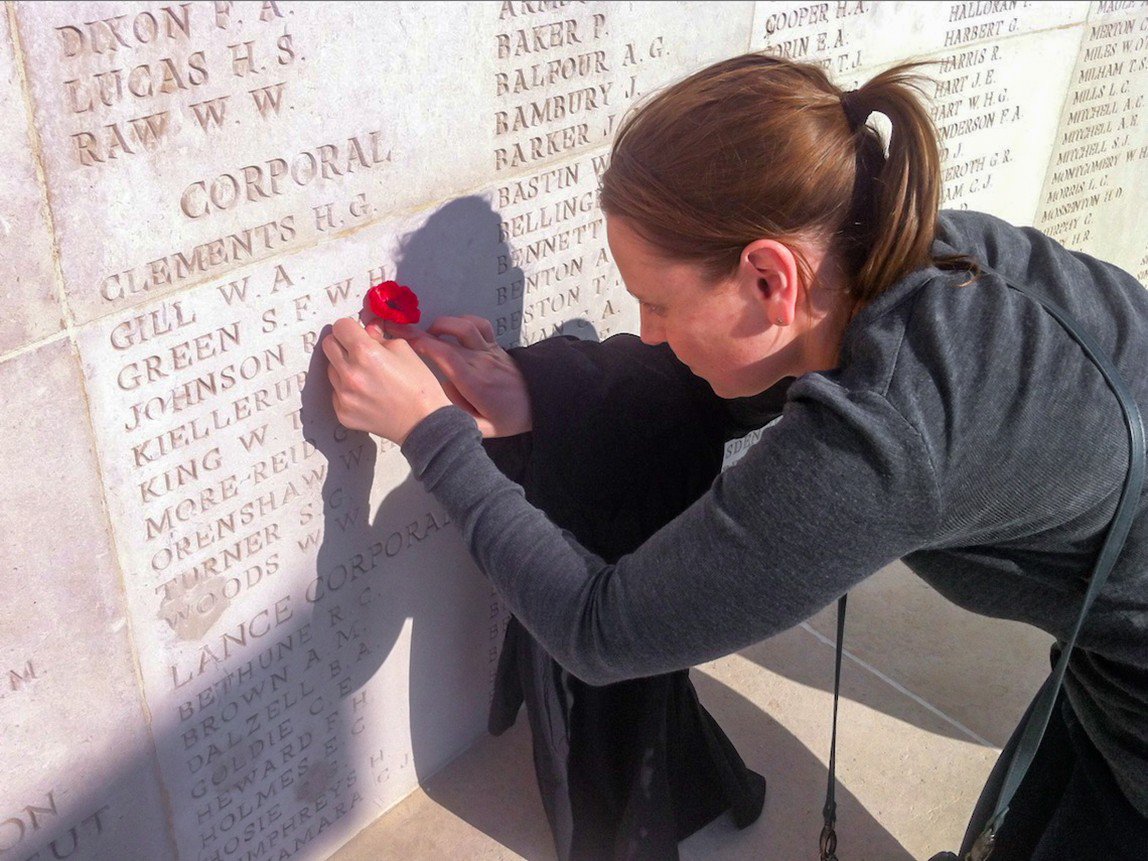Robert William JOHNSON
Eyes grey, Hair dark, Complexion dark
Bob Johnson – Did he Reach the Sugar Loaf?
Can you help find Bob?
After the Battle of Fromelles there are no records of Bob’s burial, but ID Disk was recovered and returned by the Germans.
A mass grave was found in 2008 at Fromelles, a grave the Germans dug for 250 Australian soldiers they recovered after the battle. As of 2024, 180 of these soldiers have been able to be identified via DNA testing. We welcome all branches of his family to come forward to donate DNA to help with his identification.
If you know anything of contacts for Bob, especially those with roots in Adelaide or Durham or Cheshire, England, please contact the Fromelles Association.
See the DNA box at the end of the story for what we do know about his family.
Early Life
With appreciation to Bob’s great nephew Wayne Thomas for the family information .
Wayne Thomas’s father told Wayne that his grandmother (Jane Johnson) had a photo on the wall of an uncle who was killed in the war. Wayne wanted to find out more, so he started to look into Bob’s Johnson’s Army records…
Robert William Johnson, known as Bob, was born in 1885 in Adelaide, South Australia, the son of James Watson Johnson (1835-1904), a bushman, and Mary Wainwright (1848-1896). His father had emigrated from St Mary the Less, Durham, England, in 1861. James and Mary were married at St Patrick’s Church, Adelaide, in 1866.
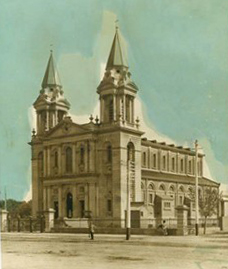
Bob grew up in a large family (2 boys died in infancy:
- Jane Johnson (1867–1944), married John Thomas
- Johanna (Annie) Johnson (1870–1950), married James Scott
- James Johnson (1871–[unknown]) likely died infancy
- Rosanna (Rose) Eva Johnson (1872–1956), married George Stuart
- William John Johnson (1876–1876), died in infancy
- Mary Ann Johnson (1878–1957), married John Augustine
- John Thomas Johnson (1881–1910), died aged 29
- Robert William (Bob) Johnson (1885–1916), killed in action at Fromelles
- Ada Emma Johnson (1887–1971), married Alfred Cowell
Bob’s childhood was marked by loss. His mother Mary died in1896 when Bob was eleven and then, just three years later, he lost his father. Around 1901, the Johnson family relocated from South Australia to Victoria, eventually settling at Ferntree Gully in the Dandenong Ranges.
As a young man, Bob worked as a stationer at Sands and McDougall, the large Melbourne printing and stationery firm.
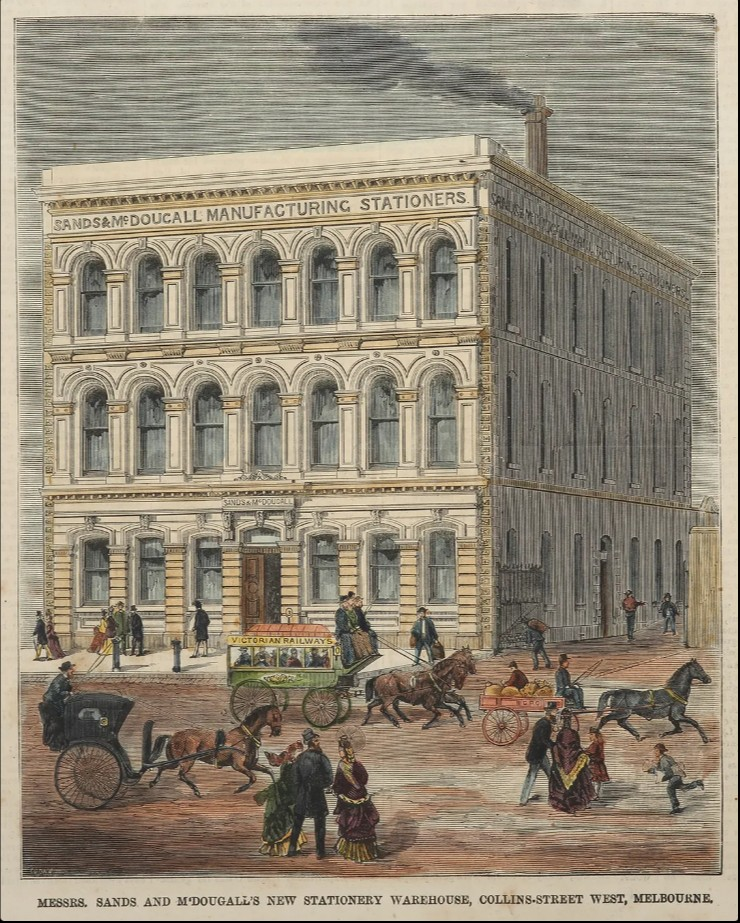
In 1910, Bob married Matilda Jane Page. They had a son, Robert Alfred, born in 1911, but he died at only twelve months old. Even more heartbreak was to come came when Matilda passed away in March 1915. He had lost his mother, his father, his wife and his son.
Later in 1915, Bob formed a de facto relationship with Rose Evelyn Matthews, who he listed as his Next of Kin when he enlisted. Rose quickly had become Bob’s closest companion as he addresses her as his wife in letters home.
Off to War
At the age of 29, Bob enlisted in the Australian Imperial Force at Broadmeadows, Victoria on 13 July 1915.
Initially posted to the 11th Reinforcements of the 8th Battalion, Bob embarked from Adelaide on 11 October 1915 aboard the HMAT A71 <i>Nestor</i>. After several weeks at sea, he arrived in Egypt in November and was posted to the 8th Battalion reinforcements.
With the ‘doubling of the AIF’ as it expanded from two infantry divisions to five, major reorganisations were underway. The 59th Battalion was raised in Egypt on 21 February 1916 at the 40,000-man training camp at Tel-el-Kebir, about 110 km northeast of Cairo. Approximately half of its recruits came from the 7th Battalion Gallipoli veterans and the other half were reinforcements from Australia. The 59th was predominantly composed of men from rural Victoria and Bob was assigned here.
His service file shows a brief administrative promotion to Sergeant, but in the reorganisation he reverted to Private the same day. Within a week, his leadership potential was recognised and he was promoted to Corporal on 4 March 1916.
In late March, the 59th were sent on a two+ day, 50 km march in thermometer-bursting heat across the Egyptian sands from Tel-el-Kebir to Ferry Post, near the Suez Canal. Prior to marching, only ½ pint of water per bottle was available.
Source: AWM4 23/15/1 15th Brigade War Diaries Feb-Mar 1916 p6
At the end of May, Bob sent Rose several postcards of pictures of France, where, still unbeknownst to him, he would soon be fighting.
One carried his last message, written on the back of a view of Neuve-Chapelle, a village north of the La Bassée Canal that had been the scene of heavy fighting in 1915 and now lay close to where the 5th Division would be. Another showed the bridge at Sailly-sur-la-Lys, a small French town just behind the Australian lines where the 59th Battalion would billet and stage for the attack at Fromelles.
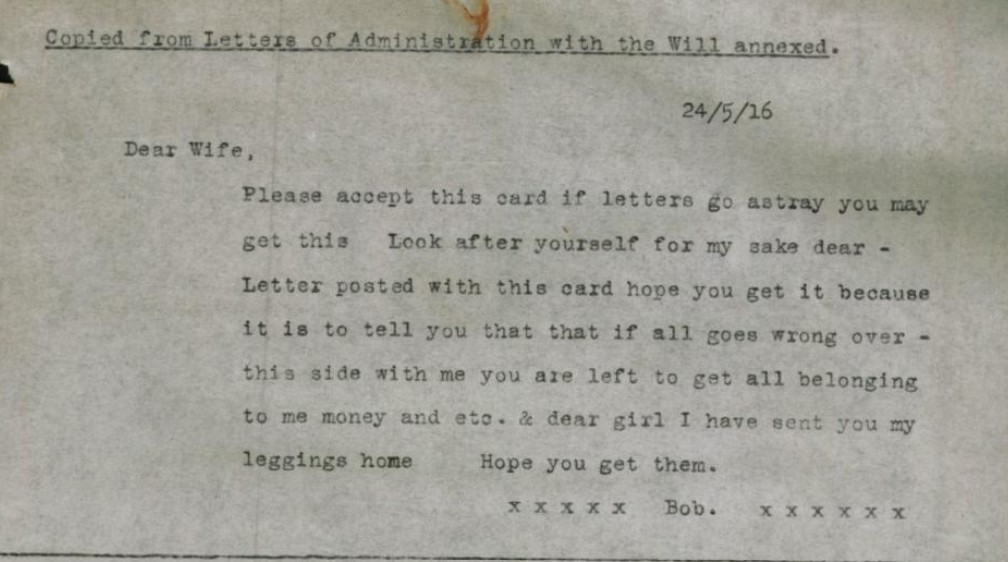
A 5th Division Sports Championship on 14 June, which was won the by the Bob’s 15th brigade. The very next day they began preparations for heading to the Western Front.
Bob departed aboard the Kinfauns Castle from Alexandria on 18 June 1916. After a brief stop in Malta, he disembarked at 7 AM in Marseilles on 29 June and by 10 PM was on a train headed for Steenbeque, 35 km from Fleurbaix in northern Frances, arriving on 2 July.
This area near Fleurbaix was known as the “Nursery Sector” – a supposedly relatively quiet area where inexperienced Allied troops could learn the harsh realities of Western Front trench warfare against the Germans. But the quiet times and the training period did not last long.
Training now had a higher sense of urgency, and it now included the use of gas masks and learning to deal with the effects of large shells.
The move to the front continued. On 9 July they were in Sailly sur la Lys, just 1000 yards from the trenches, the same as on the postcard Bob had sent to Rose in May.
The Battle of Fromelles
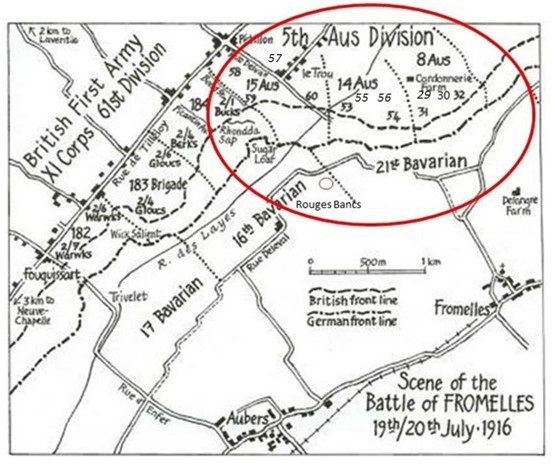
The battle plan had the 15th Brigade located just to the left of the British Army. The 59th and 60th Battalions were to be the lead units for this area of the attack, with the 58th and 57th as the ‘third and fourth’ battalions, in reserve.
The main objective for the 15th Brigade was to take the trenches to the left of a heavily armed, elevated German defensive position, the ‘Sugar Loaf’, which dominated the front lines. If the Sugar Loaf could not be taken, the other battalions would be subjected to murderous enfilade fire from the machine-guns and counterattacks from that direction. As they advanced, they were to link up with the 60th battalion and the British on their flanks.
The main attack against the Sugar Loaf position was planned for 17 July, but it was delayed due to bad weather.
On 19 July, Zero Hour for advancing from their front-line trenches was to be 5.45 PM, but the Germans knew this attack was coming and were well-prepared. They opened a massive artillery bombardment on the Australians at 5.15 PM, causing chaos and many casualties.
A fellow soldier, Bill Boyce (3022, 15th Brigade, 58th), summed the situation up well, “What have I let myself in for?”
Source: Australian War Memorial Collection C386815
Their attack on the German lines began at 5.45 PM on the 19th. The 59th went over their parapet in four waves at 5 minute intervals, but then laid down to wait for the support bombardment to end at 6 PM. A & B Companies were in the first two waves, C & D in the next two.
There was immediate and intense fire from rifles and the Sugar Loaf machine guns. As documented in the messages sent back to HQ just after the attacks began:
“cannot get on the trenches as they are full of the enemy”
“every man who rises is shot down”
“‘they were enfiladed by machine guns in the Sugar Loaf and melted away”

The British 184th Brigade just to the right of the 59th met with the same resistance, but at 8.00 PM they got orders that no further attacks would take place that night. However, the salient between the troops limited communications, leaving the Australians to continue without British support from their now fully exposed right flank. The official reports indicate advances were limited, but individuals’ reports suggest that some did reach the German parapet. However, with little support being available they had to drop back.
The attack was ended early on the morning of the 20th. At the 8.00 AM roll call, out of a battalion of about 1000 soldiers, 4 officers and 90 other ranks reported in. While there was no cease fire after the battle, parties did go to No-Man’s Land to bring back wounded soldiers, with over 200 were recovered on 20 July. To get some perspective of the battle, when Charles Bean, Australia’s official war historian, attended the battlefield two and half years later, he observed a large quantity of bones, torn uniforms and Australian kit still on the battlefield.
The initial toll on the 59th was 26 killed or died of wounds, 394 were wounded and 274 were missing – 694 soldiers. Ultimately, 334 soldiers were killed in action or died from their wounds from this battle. 239 of the soldiers were unidentified.
What Happened to Bob?
The details in Bob’s Army files have him as – 1) “missing”, 2) presumably buried in No Man’s Land, 3) a POW, 4) died of wounds while POW and 5) “killed in action”.

There is also handwritten, undated note in his file - 'presumed buried in No Man's Land at approx 5J90.43 to 5K.0.251 Sheet Hazebrouck 5A', in the general area of the 59th.

He did not survive the battle, but the Germans did recover his ID tag and his personal effects, so, despite the odds of the advancing during the attack, it is not unlikely that Bob made it deep into No Man’s Land and may have reached or fallen close to the German trenches/Sugar Loaf. What happened to his body is still unknown.
While initially recorded as “missing”, on 29 November 1916, the Army officially declared him as having been Killed in Action on 19 July 1916.
In the weeks following the battle, German records confirmed Bob’s fate. His name appeared on a Nachlassliste (list of effects) compiled by the German authorities:
“Johnson R.W., Soldier, 59th Australian Battalion, killed 19.7.16. N.0.A.0.K.6”
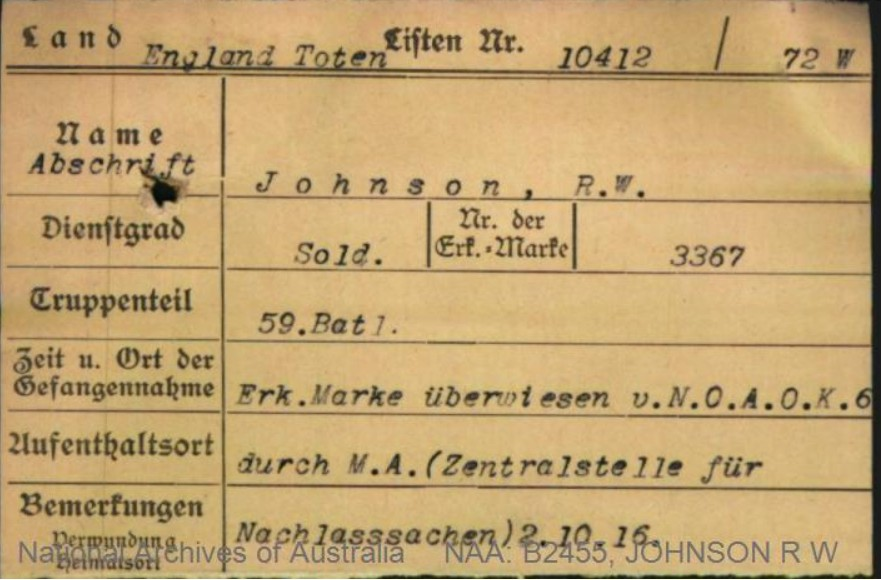
On 2 October 1916, his identification disc was handed over by the Intelligence Officer of the German 6th Army Headquarters to the Central Office for Deceased Estates. The accompanying report stated:
“Australian Soldier R.W. Johnson, Corporal, 59th Battalion, Identification Disc 3367, fell in the neighbourhood of Fromelles on 19/7/16.”
Other information continued to come in over several years and the final document was the 14 October 1920 statement from his Red Cross file.
The ‘prisoner of war’ most likely reflects his body was found by the Germans as opposed to having been taken as a ‘prisoner’, as there are no records to that effect.
After the War, Captain Charles Mills made extensive searches of the Australians who died in German Prisoner of War camps, but there is no mention of Bob.
The Family After the Battle
Bob’s family paid tribute to him with a notice placed in The Age.
Bob had named Rose as the beneficiary in his Will and, after providing the Army with a statutory declaration confirming her status as Bob’s de facto wife and legatee, she was awarded his medals – the 1914-15 Star, the British War Medal and the Victory Medal, a Memorial Plaque and a Memorial Scrroll.
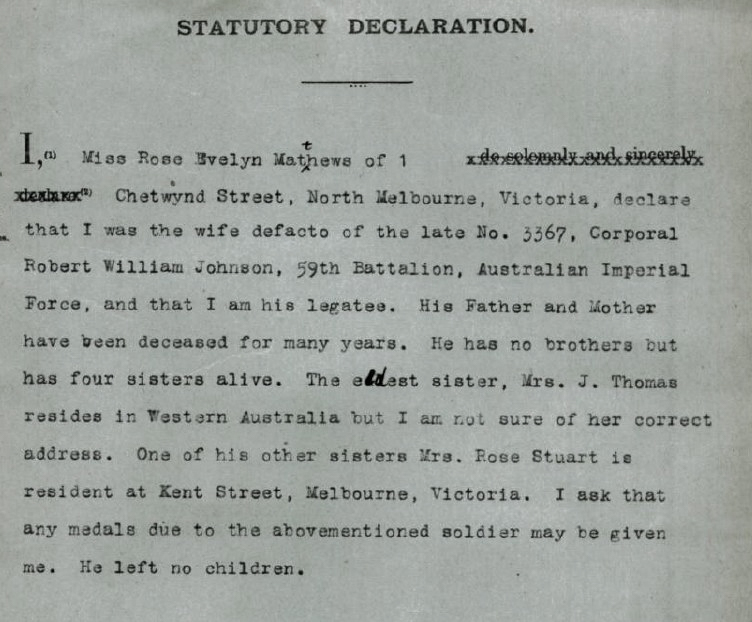
While Bob and Rose had only a few months together, it was obviously a positive point for both of their lives. In 1935, Rose married Charles Francis Henry McFee.
Bob has no known grave and is commemorated on the V.C. Corner Australian Cemetery Memorial in Fromelles and on the Australian War Memorial Roll of Honour in Canberra.
While more than 100 years ago, he remains in the memory of his family. His great-great niece Jacqui paid her respects to him at VC Corner in 2014.
Finding Bob
After the battle, the Germans recovered 250 Australian soldiers and placed them in a burial pit at Pheasant Wood. This grave was discovered in 2008 and since then efforts have been underway to identify these soldiers by DNA testing from family members. As of 2024, 180 of the soldiers have been identified, including one of the 239 unidentified soldiers from the 59th Battalion.
With Bob’s body having been found by the Germans, he could be one of the remaining unidentified soldiers. We welcome all branches of Bob’s family to come forward to donate DNA to help with his identification.
If you know anything of family contacts in Adelaide, Melbourne or Durham or Cheshire, England, please contact the Fromelles Association. We hope that one day Bob will be named and honoured with a known grave. Please visit Fromelles.info to follow the ongoing identification project and William’s story.
DNA samples are being sought for family connections to
| Soldier | Robert William Johnson (1885–1916) |
| Parents | James Watson Johnson (1835–1899), St Mary-the-Less, Durham, and Mary Wainwright (1848–1896), Goostrey, Cheshire |
| Siblings | Jane (1867–1944), married John Thomas | ||
| Hannah (Annie) (1870–1950), married James Scott | |||
| James (1871– ) | |||
| Rosa Eva (1872–1956), married George Stuart | |||
| William John (1876–1876) | |||
| Mary Ann (Annie) (1878–1957), married John Augustine | |||
| John Thomas (1881–1910) | |||
| Ada Emma (1887–1971), married Alfred Cowell |
| Grandparents | |||
| Paternal | John Johnson (1813–1850) and Mary Green (1815–1841), both from Durham | ||
| Maternal | Thomas Wainwright (1812–1859), Wakefield, Yorkshire, and Johanna (Susan) Smith (1810–1891), possibly a convict (maiden name unknown) |
Seeking DNA Donors

Contacts
(Contact: carla@fromelles.info or geoffrey@fromelles.info).
(Contact: army.uwc@defence.gov.au or phone 1800 019 090).
Donations
If you are able, please contribute to the upkeep of this resource.
(Contact: bill@fromelles.info ).
